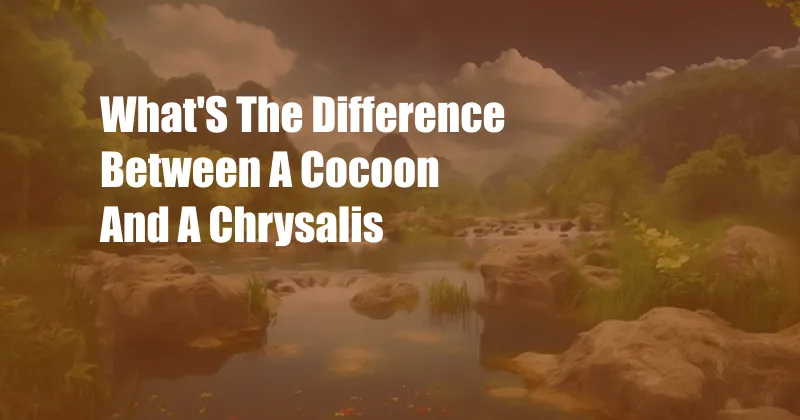
Cocoon vs. Chrysalis: Unraveling the Metamorphosis Mysteries
As a child, I was fascinated by insects. I spent countless hours observing their intriguing life cycles, particularly the awe-inspiring transformation from a crawling caterpillar to a vibrant butterfly. Two stages in this metamorphosis stood out to me: the cocoon and the chrysalis. Though often used interchangeably, I discovered that subtle differences lie between these delicate structures.
Let’s delve into the realm of these transformative wonders and unravel their unique characteristics.
Cocoons: Silken Sanctuaries
Cocoons, woven by silk-producing caterpillars, are intricate and protective enclosures. They serve as safe havens for the developing insect within. The caterpillar secretes a protein-rich substance that hardens into silken threads, forming a complex network. This cocoon provides a barrier against predators, harsh environmental conditions, and parasites.
Cocoons come in various shapes and sizes, reflecting the species of caterpillar that created them. They may be oval, spherical, or elongated, and their colors can range from white to brown or even green. The duration of the cocoon stage varies depending on the species and environmental factors.
Chrysalises: Jewel-Like Cradles
Chrysalises, in contrast to cocoons, are the hardened exoskeletons of certain insects, notably butterflies. After the caterpillar sheds its skin for the final time, its body becomes shorter and thicker, and its skin transforms into a hard, jewel-like covering.
Chrysalises provide a protective environment for the developing butterfly, shielding it from external threats. They are typically suspended from a silken pad or branch and often exhibit intricate patterns and colors. The duration of the chrysalis stage varies widely among species, ranging from a few days to several months.
Metamorphosis: A Journey of Transformation
Within both cocoons and chrysalises, a remarkable metamorphosis takes place. The caterpillar’s body undergoes a complete restructuring as it transforms into its adult form. Organs, wings, and antennae develop, while the caterpillar’s digestive system and mouthparts are replaced with those suited to its new life as a butterfly or moth.
This transformation is guided by hormones and enzymes that trigger the breakdown and rearrangement of the caterpillar’s tissues. The resulting butterfly or moth emerges with a completely different form and set of adaptations, ready to take flight in its new life.
Latest Trends and Developments
Research on cocoons and chrysalises is ongoing, with scientists exploring their unique properties and applications. For instance:
- Biodegradable Materials: Cocoons and chrysalises have inspired the development of biodegradable materials for packaging and other applications, reducing environmental waste.
- Wound Healing: Silk proteins derived from cocoons have shown promise in promoting wound healing and tissue regeneration.
- Textiles: Researchers are investigating the use of silkworm cocoons to create lightweight, durable, and naturally antibacterial textiles.
Tips and Expert Advice
For those interested in observing cocoons and chrysalises in nature, consider these tips:
- Observe Caterpillars: Keep an eye on caterpillars during their later stages to witness the formation of cocoons or chrysalises.
- Provide Protection: If you find a cocoon or chrysalis, carefully relocate it to a safe place where it can complete its transformation undisturbed.
- Patience is Key: Respect the developmental process and avoid disturbing cocoons or chrysalises prematurely.
By following these tips, you can witness firsthand the wonders of metamorphosis and gain a deeper appreciation for the intricate processes that govern the natural world
Frequently Asked Questions (FAQs)
- Q: What’s the difference between a cocoon and a chrysalis?
A: Cocoons are silky enclosures created by caterpillars, while chrysalises are the hardened exoskeletons of butterflies.
- Q: How long does it take for a caterpillar to transform into a butterfly?
A: The duration varies by species, but the process typically takes a few weeks to several months.
- Q: What happens inside a cocoon or chrysalis?
A: Within these structures, the caterpillar undergoes a complete metamorphosis, transforming into its adult form.
- Q: Can I touch a cocoon or chrysalis?
A: Avoid handling them directly, as it can disrupt their delicate development.
Conclusion
Cocoons and chrysalises, though often conflated, are distinct structures that play crucial roles in the metamorphosis of insects. They provide protection, support, and a transformative environment for their developing inhabitants. Understanding their differences and marveling at the processes that occur within them enriches our appreciation of the natural world and its intricate wonders.
Are you fascinated by the topic of metamorphosis? Share your thoughts and experiences in the comments below!